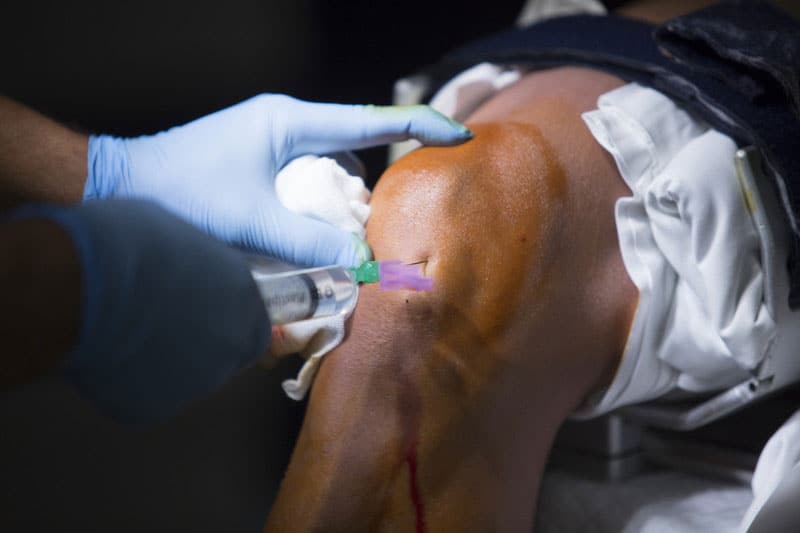Knee arthoplasty is a common minimally-invasive surgery performed in orthopedics. Reporting knee surgery can be complex as it requires a proper understanding of modifier usage, varying definitions, and payer guidelines. The ideal option for surgeons to correctly report and bill for these services is to partner with a medical coding outsourcing company that has expert coders and billing specialists on board.
Knee Arthroscopy – Points to Note
Total knee arthroscopy (TKA) involves replacing the articular surfaces of the knee, the femoral condyles and tibial plateau. In a partial knee replacement, only one part of the knee joint is replaced. Effective January 2018, TKA ceased to be an inpatient-only service for Medicare beneficiaries. This means that hospitals can receive payment from Medicare for TKA procedures “regardless of whether a beneficiary is admitted to the hospital as an inpatient or as an outpatient, assuming all other criteria are met” (MLN Matters Number: SE19002). TKA must be performed in a hospital.
Inpatient knee arthroplasty is still subject to the Two Midnight Rule, under which hospital claims are generally payable under Medicare Part A “if the admitting practitioner reasonably expects the beneficiary to require medically necessary hospital care spanning two or more midnights, and this expectation is supported by the medical record documentation.” Neverthelss, an inpatient admission may be payable on an individualized basis if the medical record documentation supports the admitting physician/practitioner’s judgment on the medical necessity of the inpatient admission.
Coverage for Knee Arthroscopy
Insurance companies have specific guidelines for medical necessity determination of knee arthroscopy. For instance, Priority Health covers knee arthroscopy for the following indications when the stated medical necessity criteria are met:
- Diagnosis or treatment of intra-articular joint pathology
- Repair of an osteochondral defect, including osteochondral dissecans
- Symptomatic acute meniscal tear on exam or MRI
- Knee osteoarthritis with a concomitant meniscal tear with specific symptoms
- Reconstruction of anterior cruciate ligament (ACL)
- Debridement, drainage, or lavage for one or more of the following:
- Rheumatoid arthritis
- Septic joint or osteomyelitis
- Septic prosthetic joint
- Postoperative arthrofibrosis
- Repair or reconstruction of posterior cruciate ligament (PCL)
- Excision of popliteal (Baker) cyst
- Synovectomy
- Lateral retinacular release for patellar pathology
CPT Codes for Common Arthroscopic Knee Procedures
The most common types of knee arthroscopic surgery include repair of a torn meniscus, ligament reconstruction, removal of loose debris and trimming damaged cartilage.
- 27438 Arthroplasty, patella; with prosthesis
- 27446 Arthroplasty, knee, condyle and plateau; medial OR lateral compartment
- 27447 Arthroplasty, knee, condyle and plateau; medial AND lateral compartments with or without patella resurfacing (total knee arthroplasty)
- 27486 Revision of total knee arthroplasty, with or without allograft; 1 component
- 27487 Revision of total knee arthroplasty, with or without allograft; femoral and entire tibial component
- 27488 Removal of prosthesis, including total knee prosthesis, methylmethacrylate with or without insertion of spacer, knee
- 29850 – Arthroscopically aided treatment of intercondylar spine(s) and/or tuberosity fracture(s) of the knee, with or without manipulation; without internal or external fixation (includes arthroscopy)
- 29851 – Arthroscopically aided treatment of intercondylar spine(s) and/or tuberosity fracture(s) of the knee, with or without manipulation; with internal or external fixation (includes arthroscopy)
- 29855 – Arthroscopically aided treatment of tibial fracture, proximal (plateau); unicondylar, includes internal fixation, when performed (includes arthroscopy)
- 29856 – Arthroscopically aided treatment of tibial fracture, proximal (plateau); bicondylar, includes internal fixation, when performed (includes arthroscopy)
- 29866 – Arthroscopy, knee, surgical; osteochondral autograft(s) (e.g., mosaicplasty) (includes harvesting of the autograft[s])
- 29867 – Arthroscopy, knee, surgical; osteochondral allograft (e.g., mosaicplasty)
- 29868 – Arthroscopy, knee, surgical; meniscal transplantation (includes arthrotomy for meniscal insertion), medial or lateral
- 29870 – Arthroscopy, knee, diagnostic, with or without synovial biopsy (separate procedure)
- 29873 – Arthroscopy, knee, surgical; with lateral release
- 29874 – Arthroscopy, knee, surgical; for removal of loose body or foreign body (e.g., osteochondritis dissecans fragmentation, chondral fragmentation)
- 29875 – Arthroscopy, knee, surgical; synovectomy, limited (e.g., plica or shelf resection) (separate procedure)
- 29876 – Arthroscopy, knee, surgical; synovectomy, major, two or more compartments (e.g., medial or lateral)
- 29877 – Arthroscopy, knee, surgical; debridement/shaving of articular cartilage (chondroplasty)
- 29879 – Arthroscopy, knee, surgical; abrasion arthroplasty (includes chondroplasty where necessary) or multiple drilling or microfracture
- 29880 – Arthroscopy, knee, surgical; with meniscectomy (medial AND lateral, including any meniscal shaving)
- 29881 – Arthroscopy, knee, surgical; with meniscectomy (medial OR lateral, including any meniscal shaving)
- 29882 – Arthroscopy, knee, surgical; with meniscus repair (medial OR lateral)
- 29883 – Arthroscopy, knee, surgical; with meniscus repair (medial AND lateral)
- 29884 – Arthroscopy, knee, surgical; with lysis of adhesions, with or without manipulation (separate procedure)
- 29888 – Arthroscopically aided anterior cruciate ligament repair/augmentation or reconstruction
- 29889 – Arthroscopically aided posterior cruciate ligament repair/augmentation or reconstruction
Modifiers
The two common modifiers for arthroscopy are 51 and 59:
- 51 (multiple procedures) – Modifier 51 indicates that the same provider performed multiple procedures (other than E/M services) at the same session. The most resource consuming procedure should be listed first, and modifier 51 should be appended to the second and subsequent procedure.
- 59 (distinct procedural service) – Modifier 59 identifies procedures/services that are not normally reported together, but are appropriate under the circumstances, and should be used if the codes meet the criteria for separate reporting and ensuring payment. Modifier 59 may indicate a separate lesion or a separate injury, not normally encountered or treated on the same day by the same provider.
An article published by the American Academy of Orthopedic Surgeons (AAOS) provides the following guidance on using common knee arthroscopy codes:
- Chondroplasty (CPT code 29877) is not included when it is performed in a different compartment than a meniscal repair (CPT codes 29882 and 29883). If a meniscal repair is done in the medial compartment, the provider can bill for chondroplasty in either the lateral compartment or the patellofemoral compartment.
- Arthroscopic removal of a loose/ or foreign body is reported using CPT code for 29874. If this code is used the loose or foreign body must be larger than 5 mm or it must be removed through a separate incision.
- Add-on code (G0289) arthroscopy, knee, surgical, for removal of loose body, foreign body, debridement/shaving of articular cartilage (chrondroplasty) at the time of other surgical knee arthroscopy in a different compartment of the same knee can be reported for removal of a loose or foreign body with a menisectomy code if the body was removed from a different compartment of the same knee.
- CPT code 29875 limited synovectomy can be reported only if it is the only procedure performed. This procedure usually considered a part of any more extensive procedure performed in the same anatomic site and not separately reportable. CPT code 29876 major synovectomy two or more compartments when performed should be used only when the synovium has an underlying pathology such as rheumatoid arthritis or pigmented villonodular synovitis.
Bundling and unbundling typically depend on the compartment and the type of surgery performed. Experienced medical billing service companies have teams of expert coders and billing specialists that can ensure correct reporting of knee arthroscopy. They would be aware of when to bundle services and when to report them separately. They will also ensure that the procedure being billed is documented as medically necessary and based upon the diagnosis.




